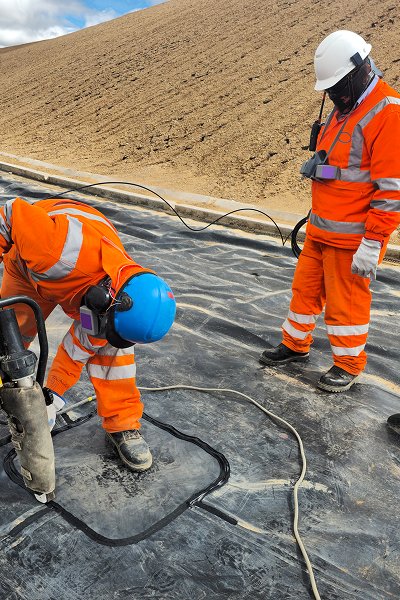Triaxial geogrid is a polymer synthetic material manufactured by mechanical punching and three-way stretching process. It has a grid structure with balanced tensile strength in multiple directions (usually three directions). Its mesh is arranged in hexagons or triangles, which can evenly disperse stress in any direction in the plane, achieving good reinforcement and anti-deformation capabilities.

High-density polyethylene (HDPE), polypropylene (PP) or polyester (PET) and other polymer materials have excellent corrosion resistance, aging resistance and toughness. By adding UV inhibitors and stabilizers, their durability in long-term outdoor use can be significantly improved.
Structural design
The mesh of the triaxial grid is generally equilateral triangle, regular hexagon or honeycomb, and its three-way stretching forming process ensures the following core features:
Three-way balanced tensile strength: it can withstand external forces in any direction to ensure uniform reinforcement of the soil;
Strong structural stability: the triangular structure is the most stable basic figure in engineering mechanics;
High node strength: the cross node formed by stretching has a higher overall shear bearing capacity;
High overall stiffness: compared with traditional grids, its shear modulus and overall rigidity are better.
How to Correctly Select and Purchase Triaxial geogrid
Project purpose
Is it used for highway base reinforcement?
Or for soft soil foundation reinforcement?
Or for special environments such as port embankments and slope stability?
Different engineering needs have different requirements for the strength, durability, size and specifications of the grid.
Design load and service life
For temporary projects, medium and low strength products can be used;
For high-load areas such as bridgeheads, airports, ports, etc., high-strength and long-life products (such as PET materials and thicker ones) should be given priority;
For long-term loads and fatigue repeated structures, materials with better UV resistance and corrosion resistance should be selected.
Road engineering
Roadbed reinforcement of highways and mine roads: especially suitable for mining transportation roads that are subjected to long-term heavy vehicle rolling;
Strengthening of base structure: delaying rutting and road surface settlement, and improving service life;
Convenient construction: can be laid quickly, reducing initial construction costs.
Airport runways and freight terminals
Carrying high-frequency and high-load wheel pressure: dispersing loads to prevent structural damage;
Strong fatigue resistance: improving the overall structural deformation resistance.
Port and dam engineering
Impact and wave resistance: enhancing structural durability and safety;
Soft foundation stability: especially suitable for land reclamation and soft clay foundation.
Slopes and retaining walls
Anti-slip and anti-cracking: enhancing slope stability;
Can be combined with vegetation nets to form a green protection system.


Construction technology of triaxial geogrid
Lay the triaxial grille in sequence along the control line;
Requires flat, tight, wrinkle-free, and no flipping;
Generally, lay it upward from the downhill side to prevent rainwater from seeping in.
Use U-shaped steel nails, anchor nails, bamboo nails or plastic pins to fix the edge of the grille every 1 to 2 meters;
Pay special attention to the anchoring of corners and overlaps to prevent displacement or bulging;
For temporary roads, fillers can be used to compact the corners directly.
The horizontal overlap of the grille should not be less than 20cm, and the vertical overlap should not be less than 30cm;
It is recommended to reinforce the connection in areas with frequent construction traffic, such as nylon tie-ties and wire binding;
If the design requires double-layer laying, the seams must be staggered to avoid overlapping interfaces.
After paving is completed, backfill with crushed stone or gravel with moderate particle size and good grading in time;
The thickness of the first layer of filler is generally not less than 15cm;
Construction vehicles should be prohibited from directly rolling over uncovered areas during paving;
Backfill should be rolled layer by layer, with each layer not exceeding 30cm in thickness, and the compaction degree should meet the design specifications.


